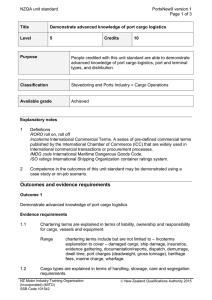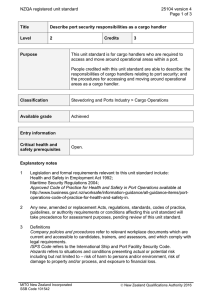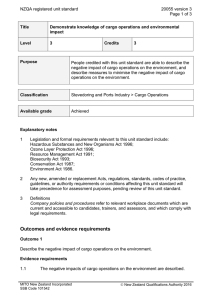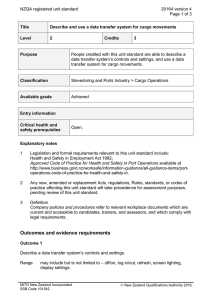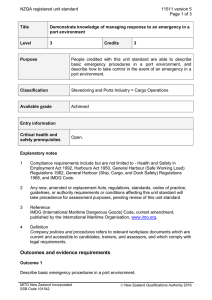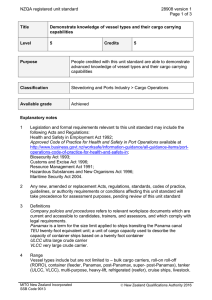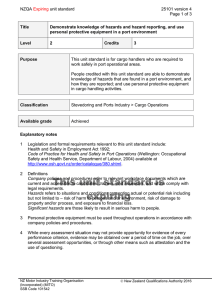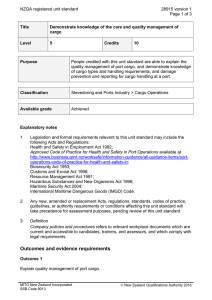NZQA registered unit standard 28906 version 1 Page 1 of 3
advertisement
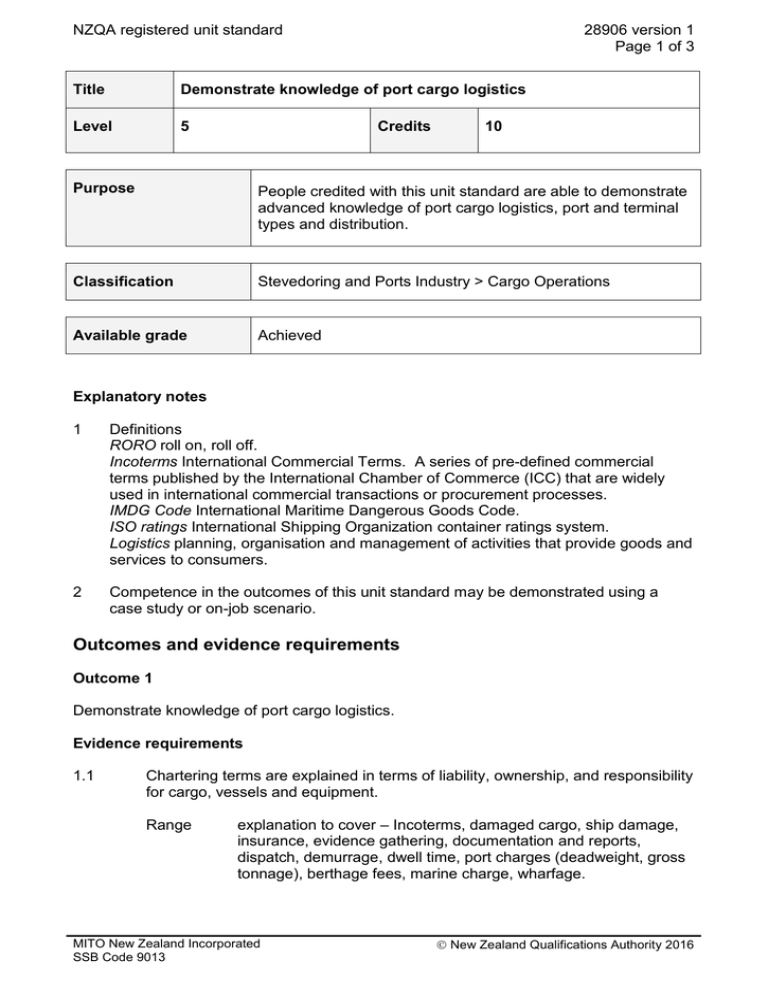
NZQA registered unit standard 28906 version 1 Page 1 of 3 Title Demonstrate knowledge of port cargo logistics Level 5 Credits 10 Purpose People credited with this unit standard are able to demonstrate advanced knowledge of port cargo logistics, port and terminal types and distribution. Classification Stevedoring and Ports Industry > Cargo Operations Available grade Achieved Explanatory notes 1 Definitions RORO roll on, roll off. Incoterms International Commercial Terms. A series of pre-defined commercial terms published by the International Chamber of Commerce (ICC) that are widely used in international commercial transactions or procurement processes. IMDG Code International Maritime Dangerous Goods Code. ISO ratings International Shipping Organization container ratings system. Logistics planning, organisation and management of activities that provide goods and services to consumers. 2 Competence in the outcomes of this unit standard may be demonstrated using a case study or on-job scenario. Outcomes and evidence requirements Outcome 1 Demonstrate knowledge of port cargo logistics. Evidence requirements 1.1 Chartering terms are explained in terms of liability, ownership, and responsibility for cargo, vessels and equipment. Range explanation to cover – Incoterms, damaged cargo, ship damage, insurance, evidence gathering, documentation and reports, dispatch, demurrage, dwell time, port charges (deadweight, gross tonnage), berthage fees, marine charge, wharfage. MITO New Zealand Incorporated SSB Code 9013 New Zealand Qualifications Authority 2016 NZQA registered unit standard 1.2 28906 version 1 Page 2 of 3 Cargo types are explained in terms of handling, stowage, care, and segregation requirements. cargo types include but are not limited to – container – ISO rating, size, type; types include – refrigerated, dry, over height, high cube, flat rack, food grade, heavy rated; breakbulk – logs, pulp, timber, paper, steel, palletised, unitised, ingots; bulk – coal, grain, cement, fertiliser, sand, salt, urea, palm kernel, sugar, gypsum, wood chip, scrap metal; bulk liquid – petroleum, oil, molasses, wine, water, rum, tallow, chemicals, gas (LPG/CNG); specialised – project cargo, hazardous (IMDG code), explosive, refrigerated; livestock; passengers; RORO. Range Outcome 2 Demonstrate knowledge of port and terminal types and distribution. Range port and terminal types include but are not limited to – hubs, off-port depots, log yards/log storage yards, bulk storage yards, container terminals, liquid terminals, passenger terminals, RORO terminals, customs bonded areas, security. Evidence requirements 2.1 Port and terminal types are explained in terms of their purpose, advantages, and disadvantages. 2.2 Port and terminal stakeholders are identified and how and why they use the facilities is explained. Range includes but is not limited to – user groups, operators. 2.3 Knowledge of cargo flow constraints through the supply chain of ports and terminals is demonstrated for a port. 2.4 Knowledge of the use of logistics technology used in the supply chain of ports and terminals is demonstrated for a port. Planned review date MITO New Zealand Incorporated SSB Code 9013 31 December 2020 New Zealand Qualifications Authority 2016 NZQA registered unit standard 28906 version 1 Page 3 of 3 Status information and last date for assessment for superseded versions Process Version Date Last Date for Assessment Registration 1 17 September 2015 N/A Consent and Moderation Requirements (CMR) reference 0145 This CMR can be accessed at http://www.nzqa.govt.nz/framework/search/index.do. Please note Providers must be granted consent to assess against standards (accredited) by NZQA, before they can report credits from assessment against unit standards or deliver courses of study leading to that assessment. Industry Training Organisations must be granted consent to assess against standards by NZQA before they can register credits from assessment against unit standards. Providers and Industry Training Organisations, which have been granted consent and which are assessing against unit standards must engage with the moderation system that applies to those standards. Requirements for consent to assess and an outline of the moderation system that applies to this standard are outlined in the Consent and Moderation Requirements (CMRs). The CMR also includes useful information about special requirements for organisations wishing to develop education and training programmes, such as minimum qualifications for tutors and assessors, and special resource requirements. Comments on this unit standard Please contact the NZ Motor Industry Training Organisation (Incorporated) (MITO) info@mito.org.nz if you wish to suggest changes to the content of this unit standard. MITO New Zealand Incorporated SSB Code 9013 New Zealand Qualifications Authority 2016
